|
|
|
|||
|
|
||||
|
|
||||
| Racing Car and Speedboat Kits | ||||
|
|
HOME | SITE MAP | FORUM | CONTACT |
|
||
|
ABOUT | MOTORS | MODELS | ARCHIVE | HISTORY | STORE | FAQ | LINKS
|
|
|
|
|||||||||||||||||||||
|
Not just aeromodelling
Designers of kits for Jetex propulsion did not confine their creativity to model aircraft. The micro rocket motors had obvious possibilities for powering model racing cars and speedboats. A number of manufacturers seized the opportunity to produce kits that modelled both actual and imaginary jet-powered cars and boats. |
|
|||||||||||||||||||||
|
|
|
|
|
|
|||
|
Jetex 40 MPH Racecar (1948)

- photograph by Nigel Smalley
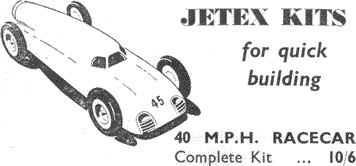
- from advertisement in Model Aeronautics, 1949
|
One of the very first kits to be produced by Wilmot Mansour, in 1948, for their new Jetex motors, was this "40 MPH Jet Racer". The kitset of balsa body parts came "complete with glue, aluminium wheels, tyres, etc." There was "no solder required" and it was designed "for use with Jetex 100 or Jetex 200", the first two motors released by Wilmot Mansour. Nigel Smalley, contributed the photo, says:
The lower illustration is extracted from a Wilmot Mansour advertisement in Bill Dean and Ron Warring's Model Aeronautics of May 1949, mainly featuring the newly released Jetex 50 motor. When Wilmot Mansour introduced a plastic "ready-to-run" racing car model for the Jetex 50 a couple of years later, this balsa kitset model was phased out. |
|||
|
|
|
|||
|
Adamcraft Jet-Ho
 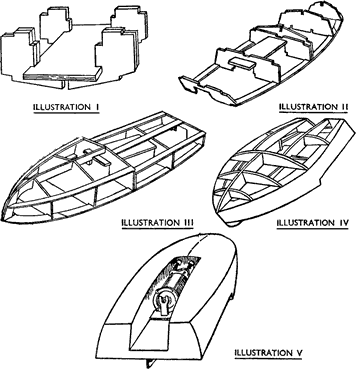 |
The Adamcraft 'Jet-Ho' Jet Propelled Model Hydroplane was designed to be powered by a Thanks to Derick Scott, we have his superb scans of the plan and printwood available for download and printing (click on each link below to download or view in a new browser window): Each download file is set set to print as a full-size image. If you want to print it in full, you'll need to save it to disk, then open it in a graphics program in order to print it. (Read more about print sizes) 
- illustrations: Derick Scott ed. John Miller Crawford
|
|||
|
|
|
|||
|
The BP Bluebirds
Photographs by David Ranford (boxtop) and Mark Forster 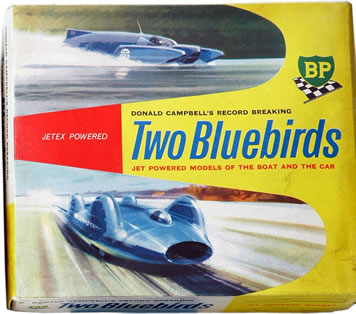 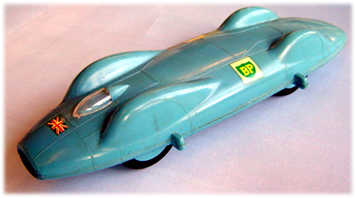 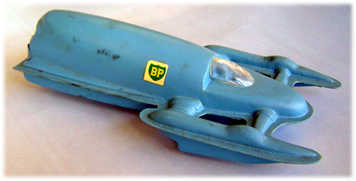   Underside of the car, showing Jetex Atom 35 mounting clip |
This handsome boxed set of two plastic models of Donald Campbell's gas turbine-powered Bluebird car and boat was a promotional offer from BP (British Petroleum). It was available through BP's petrol station network in the UK, during 1960. Replacement Jetex fuel pellets for the Atom 35 motor could also be bought from BP stations. It was during that year of 1960 that interest was particularly intense in Campbell and his Bluebirds. In the previous year, he had broken the "water barrier" of 250 mph with the boat, and that year was preparing for an attempt on the land speed record with a completely new Bluebird car. BP, which was Campbell's official supplier of fuel and lubricants, obviously saw an attractive marketing opportunity in using a Jetex motor to power models of the Bluebirds. The box included a Jetex Atom 35 motor, fuel and wick. A sheet of "Motor Operating Instructions" covered standard Jetex procedures for loading, starting, cleaning and reloading, as well as a number of "do's" and "dont's". It was noted that "the motor is also suitable for model aircraft", quoting specifications applicable to Atom 35-powered aircraft. There was also an illustrated brochure promoting the "BP Book of the Racing Campbells" which was written by "Britain's foremost motoring author, Richard Hough" and comprised "160 pages of richly illustrated drama". The brochure also gave information on Campbell, his vehicles and team, and – not surprisingly – BP's contribution to his record attempts. The photo of the Bluebird car in the brochure was of a mock-up, however, showing that the promotion must have been devised in 1959. Campbell trialled the actual car (Bluebird CN7 version 1) at Bonneville Salt Flats, Utah in September 1960, resulting in a spectacular crash, which wrecked the car and almost killed Campbell. Rebuilt as CN7 version 2 with a large tail fin, it went on to break the world land speed record in 1964 on Lake Eyre in Australia. As for the boat, while the brochure has an actual photo of Bluebird K7, in which Campbell broke his own world record for the sixth time on Lake Coniston in May 1959, the model is of the 1957 version. Powered by a MV Beryl turbo-jet from the Saro SR.A1, the earlier version lacked the small tail fin that was added in 1958 and is clearly depicted in the box artwork. It was in the 1967 Bluebird K7, with a much enlarged tail fin and more powerful Orpheus jet engine, that Campbell, travelling at a reported speed of 328 mph, made his final and fatal record attempt.  Donald Campbell with Leo Villa, his chief mechanic, in front of Bluebird K7
- from the accompanying Donald Campbell's Two Bluebirds brochure
|
|||
|
|
|
|||
|
Jetex Jet Propelled Racing Car (1950)
 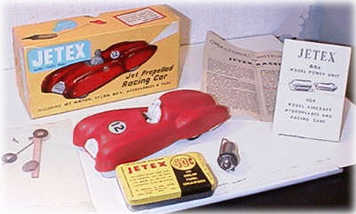  |
Wilmot Mansour promoted this 6¾in. long Introduced in early 1950, it superseded an earlier balsa-wood "40 MPH Jet Racer" that had required building and painting. Advertising for this new plastic car claimed for it a speed of "approx. 20 m.p.h." The kit included a "pylon attachment", which enabled the box to be used as the pylon itself, for tethered round-the-pole operation. The upper illustrations at left are of the 1951 version, which used the original Jetex 50, with its flat end cap and nozzle. The midd le illustration shows a later version, marketed by Sebel and packaged with a Jetex 50C motor. A 1965 advertisement claimed its speed as 40 m.p.h. with "a running time of nearly a quarter minute with two standard pellets". Yet its price, which had been 18/11d. in 1951 had fallen to 16/6d. (though the racing number had changed – ominously, perhaps – to 13). As the lower illustration shows, Wilmot Mansour offered a range of colours for the car, unlike Henry Ford’s Model T, which customers could famously buy in any colour – as long as it was black. No doubt the different colours made it easier for purchasers to race the cars and readily distinguish the winner – even if the racing number was fixed at 12 for most. |
|||
|
|
|
|||
|
Monogram Firebolt (1959)
 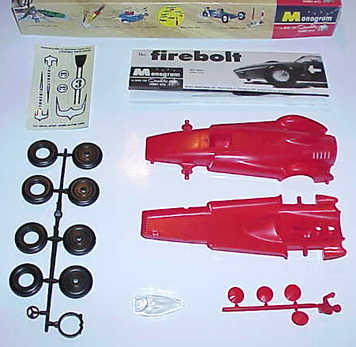 |
In the United States, Monogram issued this plastic kit of a concept “Jet Power Racer”, explaining its design in these words:
The kit was reissued by Revell in 1997 – Mike Mulligan, who bought the one shown here, says:
Mike has contributed additional photos >> |
|||
|
|
|
|||
|
Jetex Record Breaking Jet Car (1965)
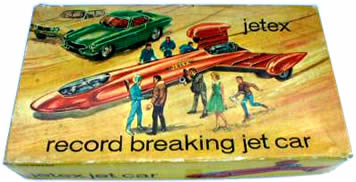  |
Though Jetex sales were in decline by 1965, the design team at Sebel were keen to introduce new models and expand the market. Racing cars and speedboats had been steady sellers for Jetex (see above) and the initiative was taken to develop completely new models in each of these categories. One of the outcomes was this new 3-wheel “record-breaking” RTP car for the Jetex 50C. It was personally designed by Bert Judge, Sebel’s Chief Designer. With the Jetex line on the verge of being discontinued by Sebel in 1969, Bert saw salvation lying partly in the new car and hydroplane and pleaded with management for a stay of execution. In a memo he wrote, “I think Jetex could certainly be resurrected as a business proposition starting with a completely new range of kits and models, but including the Jet car and Hydroplane, at competitive prices.” Alas, his plea was not heeded and this model did not enjoy as long a spell on the market as its predecessor. The kit illustrated left sold on eBay in March 2004 for £103.56. |
|||
|
|
|
|||
|
Jetex Speedboat (1951)

- David Ranford
Though the first speedboats (such as the one shown right) came fitted with a Jetex 50B motor, later models (such as the one above) were sold with the newly introduced Atom 35. |
This Jetex plastic speedboat was introduced by Wilmot Mansour in the latter part of 1951. It was promoted in company with the Jetex racing car, the two being advertised as a "Ready-to-Run" pair. There was no assembly required apart from loading and fitting the motor. Just as the plastic car had pushed its wooden counterpart off the range of Wilmot Mansour products, so this new plastic speedboat displaced the earlier wooden hydroplane. The new fully-moulded boat was claimed to be "unsinkable" and, like its sibling car, capable of "approx. 20 m.p.h." The Jetex Speedboat was retailed in 1951 in the UK for 15/3d. The example pictured below sold on eBay in February 2003 for US $166.49. 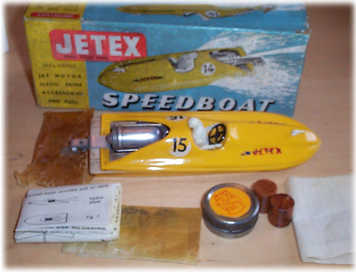 |
|||
|
|
|
|||
|
Jetex Jet Hydroplane (1965)
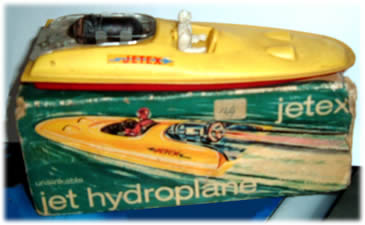 |
This Jetex “jet hydroplane” was Sebel’s 1965 revamp of Wilmot Mansour’s 1951 Jetex speedboat. Like its sister “jet car”, it came in attractive new and dynamically illustrated packaging. Note that, as with the car, the motor bay is now surrounded entirely by a metal shield, reflecting (literally!) the increased heat of the Sebel fuel. Bob Wakefield was given this model on his birthday in 1965 and, exactly 40 years later to the day, handed it over to the award winning Glendale Toy Museum, a very popular tourist attraction on the Isle of Skye, Scotland, to replace their original model which was lost in a fire in 2002 which destroyed over half their exhibits. >> See photo of handover |
|||
|
|
|
|||
|
|
|
|
|
|
|
|
Acknowledgements - Jetex 40 MPH Racecar: photograph and information contributed by Nigel Smalley; - Jetex 40 MPH Racecar: Model Aeronautics advertisement from Bill Henderson - BP Bluebirds: photographs and information contributed by Mark Forster adn David Ranford - Monogram Firebolt: photographs and information contributed by Mike Mulligan - Jetex Record-breaking Jet Car: photograph spotted on eBay by Nigel Smalley - Jetex Speedboat: photographs by David Ranford and an eBay vendor (spotted by John McKnight) - Jetex Jet Hydroplane: photograph contributed by Bob Wakefield |
|
|
|
|
ABOUT | MOTORS | MODELS | ARCHIVE | HISTORY | STORE | FAQ | LINKS |
|
|
Terms of Use
|
Queries? Corrections? Additions?
Please
contact us.
|
|